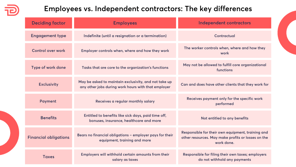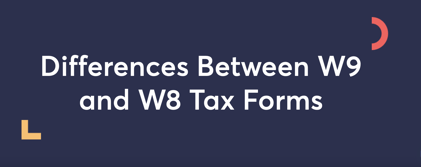How to differentiate between 1099 and W-2 workers (and why you should get this right)
- 21 Apr 2022
- 9 mins read
- Posted in
Updated: 19th February 2025
Most companies today recognise the importance of effective contractor management and the critical need to differentiate between W2 vs 1099 contractors to ensure compliance and avoid employee misclassification. After all, why restrict yourself to a small pool of local talent when you can hire the most experienced professionals from anywhere in the world?
Many workers, too, prefer a flexible model of working – especially in a post-pandemic world. Rather than clocking in at 9 and following a rigid schedule, they are now used to working remotely in a way that allows them to be there for their families and enjoy better work-life balance, even as they meet their targets and drive results. Most workers report being more productive – and you’d be hard-pressed to find anyone who actually misses the commute! This has driven a lot of talented individuals to resign, relocate and work independently as freelancers and contractors.
While this indicates a perfect scenario of companies having an optimal mix of employees and independent contractors, in reality, many employers do not fully know how to differentiate between the two. After all, with different kinds of workers, operating in different capacities, the lines do sometimes get blurred. And this can have significant fallouts. Here’s why.
The status of the workers you hire affects the federal taxes you pay as an employer – and the taxes that your workers pay too. This means, incorrect classification can get you on the wrong side of the IRS! Cue, heavy penalties, potential fines, disgruntled employees and a loss of credibility for your firm. A scenario that’s best avoided!
Let’s delve into how you can go about getting W2 vs 1099 workers right.
What are independent contractors and employees?
Understanding these classifications is vital for contractor compliance and effective management of your workforce.
Employees are the people hired to work with a company on a permanent or indefinite basis. These workers are on the company payroll, and are paid a regular salary each month along with the associated perks and benefits that they are entitled to. The company’s association with these workers continues until they resign or are terminated for some reason.
On the other side of the coin, there are independent contractors. They are independent business owners and self-employed individuals who are not on the payroll of the company, but are paid an agreed upon rate for the projects or tasks they are hired to do. Traditionally, independent contractors were only engaged to work on short-term projects and one-off requirements. But today, with the changing nature of work, it is becoming more common for companies to work with independent contractors for longer-term, recurring needs. Think an independent tech vendor who is engaged to provide ongoing IT support or a marketing consultant who’s engaged to handle a company’s month-on-month marketing efforts.
This blurs the lines between these two kinds of workers to some extent – which is why it becomes even more important to truly understand the specific definitions of each, and the key differences between them.
What is a 1099 worker?
In the US, this is the term that is used to refer to most independent contractors. Independent contractors are responsible for filing their own taxes – you, as their client, are not required to withhold any taxes the way you have to for payroll employees. In fact, up to a limit of $600 in payments, you have no tax-related responsibilities at all. But if you are a US-based company and are paying an independent contractor anything more than $600 within the calendar year, you will need to report it to the IRS by filing the 1099 form. Hence the term, 1099 workers.
You can learn more about what a 1099 form is and how to file it here 👈
Any kind of independent contractor can be termed as a 1099 worker. This includes:
- Freelancers: They are self-employed professionals who largely work alone, usually with multiple clients at once. These professionals are free to set their own terms of work, and can quote their own rates.
- Consultants: Highly trained professionals with niche experience often work with companies as consultants. They are usually brought on board for strategic inputs on high-level projects, and are extremely valued for their expertise. Since they are self-employed too, they also come under the umbrella of a 1099 worker.
- Gig workers: They are self-employed professionals who work on a more flexible and temporary basis – often taking up one-off tasks. They fulfill quicker, more impromptu requirements within a company, and they are paid an agreed upon rate once this task is complete.
- Contractors: These are self-employed workers who come to a company through a vendor or an agency. They may work with that company to cover longer-term requirements under a contract but remain off the company’s payroll. The employer sends their payments to the agency, who in turn, pays the contractor at regular intervals.
- Independent contractors: This is when contractors work independently with a company, rather than through an agency. Independent contractors may work alone, or may even own their own firms and have a team reporting to them.
What is a W-2 employee?
This refers to the permanent employees or workers on the company’s payroll. As an employer, you will have the responsibility of withholding the relevant amount of their pay as taxes.
Much like the previous category, W-2 refers to the tax form that employers have to file, to record the payments made to each employee through the year – as well as the Social Security, Medicare, Federal and State Income taxes that have been withheld. After filing the W-2 form, employees are required to be provided a copy of it.
What is the difference between W-2 and 1099 workers?
Given that many companies now work with independent contractors over the long term for recurring needs (very similar to the way they work with employees), how can one determine if an individual should be classified as a W2 vs 1099 worker? Let’s look at the key differences.
-
Degree of control:
1099 workers are independent professionals in every sense of the term – they can work when, where and how they see fit. As long as they are delivering the results agreed upon, an employer has no control over the finer details of the way they work. However, when it comes to W-2 employees, the employer has full control over work hours, location and performance of the worker. For instance, we see many employers calling their W-2 workforce back to the office now – but independent contractors can continue to work from any location they want.
-
Exclusivity:
Just like 1099 workers can decide how and where they work, they also get to decide whom they work with. You as an employer, cannot insist that they work exclusively for you, or restrict their rights to work with others while their contract with you is ongoing. Most independent workers can and do work with multiple companies at a time. W-2 employees on the other hand, usually work with one employer – and you can insist that they be available exclusively for you during the work hours you’ve set for them.
-
Resources provided:
When you bring a new W-2 employee on board, you need to fit them out with all the necessary equipment, be it laptops, headphones, keyboards – or whatever else the tools of your trade might be. Moreover, they may or may not have the specific certifications and training they’ll need to do the job – and it is up to you to provide this training. This is not so for 1099 workers. They are expected to bring their own equipment and resources, and acquire all the training and certification required, at their own cost.
-
Benefits:
Aside from their salary, all your W-2 employees are entitled to extra benefits like pension plans, sick days, paid vacations and days off, as well as any other perks your company offers – think yearly bonuses, free meals, gym memberships, child care and more. You will need to factor these costs in, when you employ your W-2 workforce. However, 1099 workers are not entitled to any perks beyond the payment for the services agreed upon. If you are working with an independent contractor who is also a business owner with a team under them, they are responsible for offering benefits to their team, rather than you as the client.
-
Taxes withheld:
Finally, as discussed above, you are responsible for withholding taxes at source for all your W-2 employees, but you have no such obligations for your 1099 workers, aside from filing and submitting the right forms at the end of the financial year.
| W-2 | 1099 | |
| Degree of control | Employers have full control over work hours, location and performance of the worker. | Employers have no control over the finer details of the way they work. |
| Exclusivity | W-2 workers usually work with one employer. | 1099 workers can decide how and where they work, they also get to decide whom they work with. |
| Resources provided | Employers need to fit them out with all the necessary equipment, be it laptops, headphones or keyboards. | These workers are expected to bring their own equipment and resources. |
| Benefits | W-2 employees are entitled to extra benefits like pension plans, sick days, paid vacations and days off. | 1099 workers are not entitled to any perks beyond the payment for the services agreed upon. |
| Taxes withheld | Employers are responsible for withholding taxes at source for all W-2 employees. | Employers just need to file and submit the right forms at the end of the financial year. |
How the IRS determines the difference between W2 and 1099 workers
Now you may have a clearer idea of how to differentiate between W2 vs 1099 workers. But are the differences always so stark in reality? Any accidental blurring of boundaries can cause the authorities to determine that your workers have been mis-classified, which may result in heavy penalties. So it is also important to understand what the IRS would look at, when they see how your workforce is classified.
-
Behavioral control:
Here, the IRS will look at whether the employer is controlling the behavioral aspects of the worker’s role – that is, whether they are controlling when, where and how the worker does their job. Do note that they see whether the employer retains the right to assert this control, even if they are not doing so. For example, in many workplaces, even W-2 employees are given the flexibility to choose where and how they work – but the employer can still tell them what to do, if they so choose. However, they cannot assert this control on 1099 workers.
The IRS will also look at how involved the employer is in the worker’s growth within the company. If they are being offered regular training and upskilling opportunities, and are being evaluated on their performance (rather than just the end results), that might indicate that the worker is a W-2 employee and not a 1099 worker.
-
Financial control:
As we saw above, W-2 employees are paid a regular salary whereas 1099 workers are paid based on hourly rates, project rates or other contractual understandings. 1099 workers are less likely to be dependent on one employer for all their earnings – they can market their offerings and get new clients to maximize their profits. But financial control goes beyond this.The IRS also looks at what kind of financial obligations and risks a worker has. A W-2 employee will have little to no financial obligations in working for an employer. Their equipment, training and other resources will all be paid for so they will have to make very little out-of-pocket investments to work with them. A 1099 worker on the other hand, will have these financial obligations. This also means that an independent 1099 worker may incur losses if they don’t take their expenses into account accurately – whereas a W-2 employee will only gain in working for an employer.
-
Type of relationship:
The employer shares a more indefinite relationship with W-2 employees – and as long as they keep performing acceptably, they have no grounds for terminating their services. In contrast, they are not required to continue working with 1099 workers after an ongoing project is over. For recurring requirements, many employers do find it easier to reach out to the same contractor for future projects as well. However, they are not obligated to do so; and the contractor too, is not obligated to accept the work if they choose not to or are not available.
The nature of the relationship also matters. If a worker receives benefits like sick days, paid time off, disability insurance and more, they are categorized as a W-2 employee. But the IRS will also look at more informal perks. This means, inviting a 1099 worker to work from the company offices or take advantage of their facilities like cafeterias, gyms etc., can inadvertently invite suspicion of them being a W-2 employee!
Should I hire W2 employees or 1099 workers?
Now let’s move on to the big question – between W2 vs 1099, which one of these workers should you hire? Deciding whether to hire W2 employees or 1099 contractors involves assessing your contractor management strategy and understanding the compliance requirements to avoid misclassification.
Hiring a W-2 employee is expected to be a longer-term engagement where you have more control, can train and retrain them based on your specific needs, and assign them to different departments if your needs change in future. However, you will need to account for overheads and expenses of training them, providing them with necessary resources and offering them employee benefits and added perks. Opting for an independent 1099 contractor comes with major advantages. They can be engaged more flexibly based on your immediate needs and given that they are already fully trained and equipped, they can start working right away. In addition, engaging 1099 workers lets you take a more result-driven hiring approach – your talent pool opens up to include experienced professionals from around the globe, who can work independently without you needing to put in the effort to manage them. However, theirs is a shorter-term engagement, so employers may find themselves needing to look for a new worker at the start of the next project. Many employers and managers also report concerns about the lack of control when engaging 1099 workers. But with the right processes and tools at one’s disposal, finding, hiring and managing 1099 workers can actually be seamless and hassle-free.
Equipping yourself to get the differentiation right
When enjoying the advantage of having a mixed workforce of 1099 workers and W-2 employees, the most important thing to remember is to classify them right at the very outset of the engagement. This saves you the stress and tension of scrambling to gather the right paperwork on a tight deadline at the end of the year – or worse, if the IRS starts investigating!
Having the right software in your toolkit can help with this more than you might realize! A solution like TalentDesk, for example, streamlines the onboarding process so you know exactly who has submitted their basic details (through Form W-9 or Form W-8 BEN as the case may be for international contractors) – and who is yet to turn in a crucial form or contract. It also helps you store them safely, thus allowing you to pull up the document you need at a moment’s notice.
Our communication platform allows you to share information securely to relevant groups, so that your 1099 workers can do their jobs independently from wherever they are. When it comes to payments too, TalentDesk helps you ensure that all invoices are paid in a timely manner as per the contract, and that proper audit trails are maintained to safeguard you against any scrutiny.
Of course, you also get the advantage of our full range of features like our project management capabilities, time tracking tools, database management and more. Essentially, TalentDesk helps you tackle many of the compliance challenges of engaging 1099 workers so you can freely enjoy the benefits they bring.

Sanhita Mukherjee
Tags
Speak to us to find out how we can help you hire the right talent for your business.
Related articles

What is a Contractor Of Record (COR)?
Discover the role of a Contractor of Record (COR) – Learn how a COR streamlines contractor compliance and safeguards your business legally.

California’s Freelance Worker Protection Act: What Businesses Need to Know
Learn how California’s Freelance Worker Protection Act (FWPA) impacts your business with compliance requirements, payment rules, and penalties.

The Hidden Complexities of Independent Contractor Classification
Read the complexities of independent contractor classification in our guide. Stay ahead with expert insights into evolving rules, tools, and future trends.

What are Global Payroll Providers: Understanding Payroll Systems
Explore the essentials of international global payroll, how it supports multinational operations, compliance, and simplifies payroll global processing.

How To Avoid Employee Misclassification
Avoid costly errors by learning about employee misclassification risks, legal ramifications and compliance strategies when classifying your workers.

Work, Reconstructed
Xenios Thrasyvoulou and Glen Hodgson discusses the main compliance issues that are faced today within the talent and HR sectors.

What is an Agent of Record (AOR)?
Read about the essential role of an Agent of Record (AOR) in representing freelancers and contractors globally, ensuring compliance and smooth operations.

Differences Between W9 and W8 Tax Forms
Unravel the purposes of W-8 and W-9 tax forms, download them, understand when and how to use them, and navigate the complexities of US tax compliance effectively.
How to pay 1099 employees
How to pay 1099 employees
Navigate 1099 employee payments and paying 1099 employees with ease. Learn how to ensure timely, compliant compensation for your contractor workforce. ‘

PEO vs. EOR: What's the difference?
Though similar, PEOs and EORs have key differences. Learn the distinctions and find out which is right for your business.

